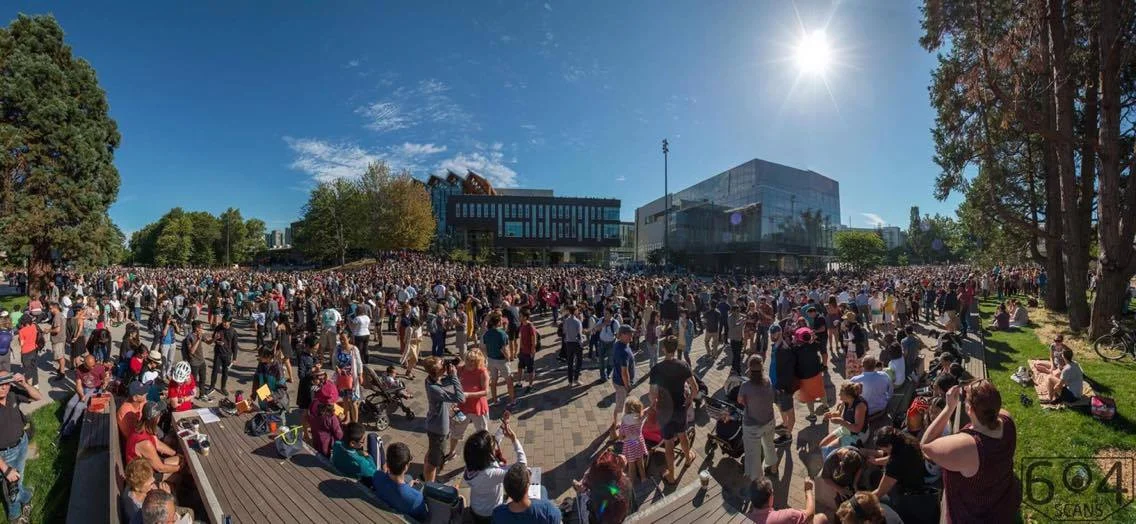
In 1999, an iconic Jaffa Cake advert hit primetime British TV. (If you don’t know what a jaffa cake is, they sell them in London Drugs. You’re welcome.) It went like this: a teacher held up a jaffa cake to an entranced group of five-year-olds apparently in astronomy class. “Full moon,” she said, referencing its beguiling roundness. She took a presumably delectable and definitely detectable bite.
“Half moon,” she said, holding it up to the now slack-jawed and drooling children and, indeed, it did resemble a half moon. Then she triumphantly stuffed the rest in her mouth, and “total eclipse!” she crowed.
The implication hung heavily that it wasn’t her first performance and that it wouldn’t be her last. Any self-respecting millennial knows that to eat a jaffa cake, you have to reenact the whole thing — and you can’t see an eclipse without thinking a luscious orangey chocolate biscuit wouldn’t go amiss.
Monday’s eclipse was one of the most anticipated astronomical phenomena observable from Earth. People across the globe had a chance to witness a rare treat either in person or through one of many live webcasts. Although the path of totality crossed directly over the United States, many viewers in Canada, Central and northern South America as well as in Africa and Europe were able to see a partial eclipse.
Why was this eclipse so popular? Steffani Grondin, the co-president of the UBC Astronomy Club, stated that while this solar eclipse is happening during a solar minimum — where sunspot and solar flare activity is low — this one “is big because the last total solar eclipse that was viewable from Vancouver was approximately 100 years ago.”
Grondin further stated that with the reach of social media and the fact that “the city has gotten more crowded … everyone is watching” this eclipse.
With Monday’s eclipse being “the closest to Vancouver in a decade,” Grondin explained that this eclipse “reach[ed] 86 percent totality” meaning that “the sun [was] 86 percent covered by the moon.”
Here in Vancouver, there were many solar eclipse parties across the city hosted by a variety of organizations, including the UBC Astronomy Club’s which took place at the Vancouver Art Gallery. Grondin said that the event was one of the public outreach events organized by the club.
With an estimated 100 people gathered an hour before the event started, the club executive team estimated that in total around 500 people came to the Vancouver Art Gallery for the viewing party. Additionally, with protective equipment such as solar viewers and solar glasses being so hard to come by leading up to the event, it was no wonder that crowds gathered before the executive team arrived.
Anticipating a crowd of 300, the club was not able to provide everyone that attended the event with a solar viewer but encouraged sharing so that everyone would be able to have a chance to view the eclipse safely. In addition, the club had three telescopes from which the eclipse could be viewed by attendees.
With viewers being sold for five dollars each, UBC Astronomy Club plans on using any leftover money for future public outreach events. Past events have included Blackout: Night Sky Festival held at UBC’s Museum of Anthropology.
“Whether you’re a PhD student studying dark matter,” or simply like looking up at the stars, Grondin stated that the UBC Astronomy Club is “an open and inclusive club for everyone and all of our events are tailored for various astronomy backgrounds and interests.”
On the UBC campus, the plaza encircled by the Nest and the Robert H. Lee alumni centre was buzzing with activity by 9 a.m. The gathering was hosted by the UBC Department of Physics and Astronomy. Parallel with Vancouver’s partial rather than total eclipse, the plaza was not completely full.
However, the queue for a free hand-held screen as armour for precious retinas was around 149.6 million kilometers long. Which, coincidentally, is the distance from here to the sun. The wait was well-worth the first peek through the ISO 12312-2 sunglasses.
Participants looked through their solar viewers and, as air fizzed through their teeth, gripped their companions’ arms. Up there, far away, flew Apollo, Helios, Ra, its influence undiminished by distance. The sun watches constantly and disdainfully, turning us over day after day for inspection — and around once a year, Hecate relieves us from scrutiny.
The moon streaks through space and the earth streaks in the opposite direction, with the lunar passing by the solar at 3,682 kilometers per hour. But truly, with enough distance, any movement is undetectable — the eclipse looked like just a shadow of a rock, larger each time it was glimpsed, stealing across the eye of the sun.
Another image leapt to mind, a view of the earth from far away, of tiny students and families intermingling to cover the earth’s surface underneath the moon’s eye as it conspired to hide us from the sun. As Annie Dillard writes, “the sun we see is less than half the diameter of a dime held at arm’s length.”
Yet the sun’s atomity seemed to increase its congruity. Especially during the eclipse, our position seemed somehow more tangible. Participants left with a sense of human inferiority, reaching for the crutch of a photo to describe their experience where language inevitably falls short.


![['']](https://storage.googleapis.com/ubyssey/media/renditions/eclipse_3.original.jpg)
![['']](https://storage.googleapis.com/ubyssey/media/renditions/eclipse_4_flickr_AndrewPoecker.original.jpg)